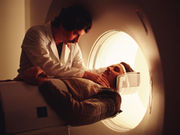Holds implications for guiding thrombolysis use when time of stroke onset unknown
FRIDAY, Nov. 18, 2016 (HealthDay News) — Computed tomography (CT) can measure brain water uptake, which can be used to identify stroke patients with symptom onset within 4.5 hours, according to a study published online Nov. 7 in the Annals of Neurology.
Jens Minnerup, M.D., from University of Münster in Germany, and colleagues evaluated whether CT-based quantification of water uptake in ischemic brain tissue can identify patients with stroke onset within 4.5 hours. Optimal cut-off value of water uptake was calculated in a derivation cohort with known time of symptom onset (178 patients) and validated in a prospective cohort from other stroke centers (240 patients).
The researchers found that in the derivation cohort, 147 patients (82.6 percent) had CT within 4.5 hours. In patients with stroke onset within 4.5 hours, the percent water uptake was significantly lower versus patients with stroke onset beyond 4.5 hours. The optimal cut-off value was 11.5 percent. When this cut-off was applied to the validation cohort the sensitivity, specificity, positive predictive value, and negative predictive value were 98.6, 90.5, 99.1, and 86.4 percent, respectively.
“Quantification of brain water uptake identifies stroke patients with symptom onset within 4.5 hours with high accuracy and may guide the decision to use thrombolysis in patients with unknown time of stroke onset,” the authors write.
One author disclosed financial ties to Siemens Healthcare, which provided technical support for CT perfusion analysis.
Full Text (subscription or payment may be required)
Copyright © 2016 HealthDay. All rights reserved.








